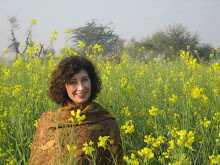
I have to admit, I'm a little in awe of Indian royalty. To me, they are living reminders of India’s illustrious past and exciting future. My first glimpse of royalty was at Rambagh Palace in Jaipur. I spotted the Maharani of Jaipur, who, along with her humanitarian and political accomplishments, was a stunning beauty in her day. At 87 years old, she was still statuesque and regal in her sky blue sari.
Last week I had the honor of meeting and interviewing the Maharaja of Jodhpur right here in Seattle. Maharaja Gaj Singh II was here to speak at the Seattle Asian Art Museum's Garden & Cosmos exhibition featuring more than 50 paintings originally from the royal collection. Chosen from more than 3,000 pieces, these little known but magnificent works of art from the 17th to the 19th century vividly depict the celebrations and pleasures of palace life, rituals of the gods, and portrayals of the cosmos.
The exhibit of primarily miniature paintings speaks volumes in all of its minute detail and vibrant color. "People have gotten into the spirit of the pictures. They conjure up the whole of India, its philosophy and art," said the Maharaja of the exhibit. Seattle is indeed lucky to host this exhibit and it wouldn't have happened without the direct involvement of the Maharaja.
While the Maharaja's background would allow him the option of resting on his laurels, he has, in fact, done the extreme opposite. His work includes preserving and promoting the arts and culture of India, maintaining and opening heritage properties and monuments to the public, work in areas of social responsibility such as empowering women through education and special projects, rehabilitating military personnel, water conservation efforts, and much more.
The Maharaja's lack of pretense and eagerness to share his ancestral link to India's culture and traditions was refreshing. During a tour of the artworks the Maharaja pointed out a detail in one painting, that of Man Singh's Coronation on January 19, 1804. In the piece, the ceremonial marble platform at the Mehrangarh Fort is the exact same one where the Maharaja himself was annointed at the tender age of four years old after the untimely death of his father. I asked the Maharaja if he remembered much of the historic moment. "I remember all the men. I had never been around so many men before," he said.
Later in the week I attended a lecture by the Maharaja. To a packed hall, he explained how the influence of his ancestors inspired him to lead through the changing times of the maharajas, especially during the "de-recognition" of the role of royal families. He saw then, and still sees his responsibility to the people. "A maharaja rules and pleases. My destiny has bound me to my heritage and the people of Jodhpur." This is evident through his works.
Maharaja Gaj Singh is one of the billions of reasons to visit India. It's clear he cares passionately about all that is precious in his country and has worked hard to maintain for future generations of residents and visitors alike. "There is so much we need to preserve and protect," said the Maharaja.




nice post about maharaja of jodhpur is shared here know about our Sunrise Health Resorts in Jaipur and water park in Jaipur, Have developed a special 7 days programme called Anti-Ageing, based on Ayurveda centre in Jaipur & ayurveda hospital in Jaipur,ayurveda treatment in Jaipur, Yoga centre in Jaipur and Naturopathy treatment in Jaipur; these ancient systems of wellness centre in Jaipur. contact-9828590094
ReplyDeleteall rajasthan
seo training institute in Jaipur
seo service in Jaipur
spa in Jaipur
spa centre in Jaipur
rajasthan government jobs
water park in Jaipur
Panchakarma treatment in Jaipur
Shirodhara treatment in jaipur
know about our Our SEO Training Institute in jaipur gives the training of Search Engine Optimization by Professional instructor to make students experts in seo promotion . Our classes based on 100% practical which develop real time SEO and SMO professionals.We are bestSEO training institute in Jaipur who also provide best seo service in Jaipur
ReplyDeleteJaipur metro map
rajasthan tourism places
Jaipur in Rajasthan
lake city udaipur tourism places
jodhpur tourism places
bikaner tour
Jaisalmer desert festival
about rajasthan
MOUNT ABU tourism places in Rajasthan
shekhawati festival
city palace in Jaipur
jantar mantar in Jaipur
albert hall museum in Jaipur
moti dungri ganeshji temple in Jaipur
hawamahal in Jaipur
Jai garh fort Jaipur
nahargarh fort in Jaipur
amber palace in Jaipur
albert hall museum in Jaipur
city palace in Jaipur
govind dev ji Temple in Jaipur
birla temple in Jaipur
bussiness opportunities in Jaipur
Achalgarh fort,Mount Abu
Get the best Insomnia Treatment in Jaipur by Dr Shri Niwash Jangir
ReplyDeleteNav imperial hospital provide the best Gynaecology services in Jaipur
ReplyDeleteGet the best kidney Stone treatment in Jaipur by expert Urology Doctor Sandeep Nunia
ReplyDelete